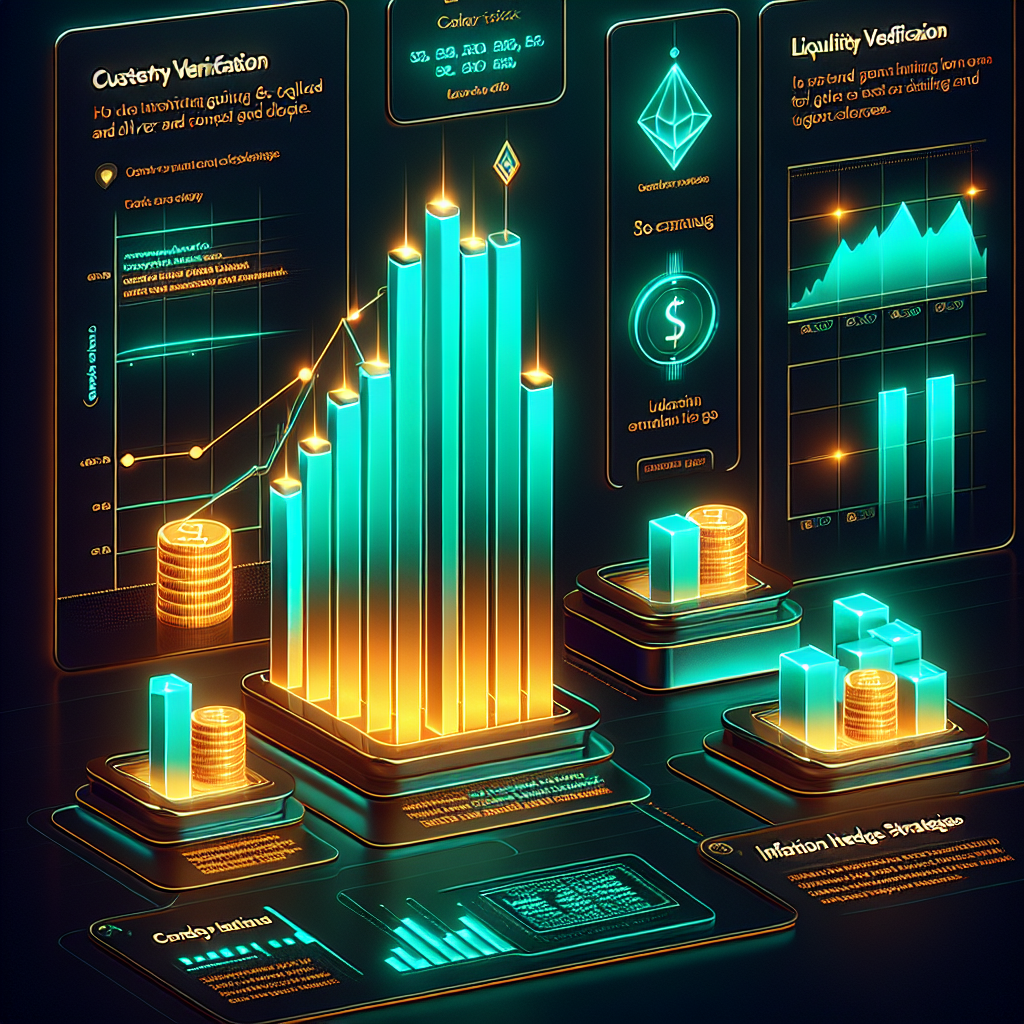Investing in Tokenized Gold and Silver: Custody Verification, Liquidity Analysis, and Inflation Hedge Strategies

Introduction to Tokenized Precious Metals
Tokenized gold and tokenized silver are digital representations of physical bullion recorded on a blockchain. Each token typically equals one troy ounce, one gram, or a fixed percentage of a vaulted bar. By marrying the timeless value of precious metals with the efficiency of distributed ledgers, investors gain fractional ownership, 24/7 global transferability, and transparent settlement. As inflation expectations rise and portfolio diversification becomes critical, understanding how to evaluate custody, liquidity, and inflation hedging characteristics is essential for anyone considering this emerging asset class.
How Tokenized Gold and Silver Work
Unlike traditional exchange-traded funds (ETFs) or futures contracts, tokenized metals embed ownership rights directly into a smart contract. A regulated custodian stores the underlying bars in high-security vaults, while an issuing entity mints blockchain tokens that are fully backed, over-collateralized, or insured. Holders can redeem tokens for physical delivery or convert them seamlessly to fiat or stablecoins on supported exchanges. This structure reduces intermediaries, lowers storage fees, and unlocks micro-investment opportunities for retail savers.
Custody Verification: Proving the Metal Exists
Independent Vault Audits
The cornerstone of tokenized bullion credibility is verifiable custody. Reputable projects commission regular third-party audits—often Big Four firms—that reconcile the total number of minted tokens with serial-numbered bars in custodial vaults. Investors should review audit reports, publication frequency, and auditor independence to confirm that backing remains 1:1.
On-Chain Proof-of-Reserve Mechanisms
Several issuers publish Merkle-tree proofs that allow anyone to verify token supply and corresponding bar lists in real time. These cryptographic attestations reduce reliance on centralized statements and increase transparency. Before purchasing, inspect whether the platform offers an on-chain proof-of-reserve dashboard and whether smart contracts are open-sourced and security-audited.
Physical Redemption Policies
True ownership hinges on the ability to take delivery. Compare minimum redemption amounts, shipping regions, and associated fees. Some platforms partner with logistics providers to deliver LBMA-certified bars, while others restrict redemption to institutional accounts. Flexible redemption boosts investor confidence that tokens are firmly anchored to tangible metal.
Liquidity Analysis: Trading Depth and Exit Options
Centralized Exchanges (CEXs)
Liquidity largely depends on listings. High-volume platforms like Binance, Coinbase, or Kraken generally offer deeper order books, tighter spreads, and faster settlement. Evaluate daily trading volumes, market-maker support, and fiat on-ramps. A token with USD, EUR, and stablecoin pairs typically enjoys broader participation and easier exit routes.
Decentralized Exchanges (DEXs)
Some tokenized metal projects leverage ERC-20 or BEP-20 standards, enabling permissionless swaps on Uniswap, PancakeSwap, or Curve. Examine total value locked (TVL), slippage, and smart-contract risk. Providing liquidity can generate yield through swap fees, but impermanent loss—especially during metal price swings—should be incorporated into your risk model.
Redemption and OTC Channels
When market conditions tighten, the ability to redeem tokens for physical bullion or to settle through over-the-counter desks provides an alternative exit. Check whether the issuer maintains relationships with bullion dealers that buy back tokens at spot. Dual liquidity venues safeguard against exchange outages and regulatory shocks.
Inflation Hedge Strategies with Tokenized Metals
Gold and silver have served as monetary hedges for centuries, often outperforming fiat currencies during high inflation. Tokenization amplifies those traditional benefits by reducing barriers to entry and allowing integration with modern yield-generating protocols.
Dollar-Cost Averaging (DCA)
Investors concerned about currency debasement can schedule automated purchases of tokenized gold or silver. By smoothing entry points, DCA minimizes timing risk and gradually builds a core hedge position that aligns with salary cycles or business cash flows.
Collateralized Lending
Several DeFi platforms accept tokenized bullion as collateral for stablecoin loans. This approach lets holders tap liquidity without triggering taxable events or sacrificing upside exposure. To mitigate liquidation risk, maintain healthy collateral ratios and monitor oracle price feeds closely.
Yield Enhancement via Liquidity Pools
Pairing tokenized metals with stablecoins in Automated Market Maker (AMM) pools can generate additional return streams that offset inflation. Compare APY, smart-contract audits, and historical volatility before allocating. Remember that yield should never compromise underlying hedge integrity; prioritize protocols with robust insurance funds and time-tested code.
Step-by-Step Guide to Investing
1. Conduct due diligence on issuers: read whitepapers, check regulatory licenses, and validate audit history.
2. Choose a secure wallet that supports the token’s blockchain (e.g., MetaMask, Ledger).
3. Create exchange accounts, complete KYC, and test small transactions.
4. Compare custody transparency, liquidity metrics, and redemption terms.
5. Diversify across multiple issuers or combine tokenized gold and silver for balanced metal exposure.
6. Implement portfolio rules: target allocation, DCA schedule, and stop-loss thresholds.
Risks and Best Practices
While tokenized metals inherit much of gold and silver’s stability, they introduce new forms of risk. Smart contract bugs, custodial insolvency, and regulatory shifts can impair value. Mitigate these threats by splitting holdings across wallets, verifying contract addresses, and tracking legislative developments in relevant jurisdictions. Hardware wallets, two-factor authentication, and multisig setups further enhance security.
Conclusion: A Modern Gateway to Time-Tested Value
Investing in tokenized gold and silver combines the scarcity and inflation-resistant qualities of precious metals with the speed, transparency, and flexibility of blockchain technology. By rigorously verifying custody, analyzing liquidity across CEX, DEX, and redemption avenues, and employing strategic hedging techniques, investors can harness this innovative vehicle to weather inflationary headwinds and fortify diversified portfolios. As adoption accelerates, disciplined due diligence and prudent risk management remain the keystones of sustainable success in the tokenized metals arena.